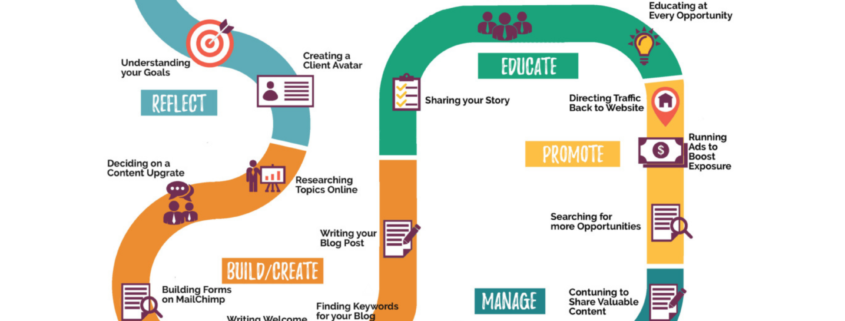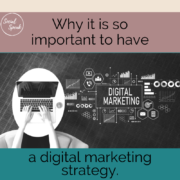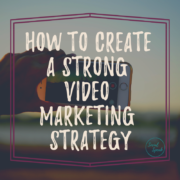One thing that has been coming up in our business a lot lately is this roadmap to digital marketing. Where do you start, when do you run ads, how do you create an online community? And a lot of times, we just want to jump into one component and hope it works. Digital marketing has grown so much over the past, just five years, just a year, six months. So it’s always changing, it’s always growing, which keeps us on our toes because they’re always adding in new things. When you think of your digital marketing, you always want to be thinking of your client or your patient’s journey.
What are they searching for, how are they going to find your content? How are they going to follow you, how are you going to build the know, like, trust factors? We created this roadmap. There’s a lot of moving pieces, and you can’t just focus on one thing.
Reflect
Let’s start up here by the very beginning, defining your company’s values. What is it that you are doing? What is important to your company? Really understanding those core values, because, in any business, you want to work with good people. You want patients that are going to love you, that are going to come back, that are going to refer their friends and family. So what are those core values that your company and your staff stand for?
If you already have this piece created, great, maybe just double-check it. Go back, look if you guys have grown or changed anything, and then moving into your goal. So what is your goal for digital marketing? Is it just brand awareness, making sure that you’re staying top of mind, that as people are searching for you on Google, that your social media is going to come up, or is it to increase leads, getting new people in the door? Is it to increase your online program, again, by getting people to sign up for your newsletter, what are those goals? And we always use the SMART goals here, so make sure that they are Specific, that they are Measurable, that they are Achievable, Realistic in Time. You don’t want to say, “I’m going to have a million followers in a week”, ’cause that’s not going to happen, but what’s that timeframe you’re going to give yourself? And then we’re going to move into a client avatar. What does this ideal patient or client look like for you? And this is really important. One of the best ways to do this, and this piece here takes a little bit of time, okay? This is kind of that step one.
Build and Create
With that client avatar, think of your favorite patients and clients that you have had. What did you love about them? Why did you love working with them? Did they… What was that relationship that you guys had? Maybe there are 10 of them. Take the common good from them and put them into this client avatar. What does that look like? Okay, so this is our step one of reflection, and then moving into step two, building and creating. So take the time to research topics online. Do a ton of Google researching and figure out… One thing I love about Google is you start typing in two things, it’s going to auto-populate different options. Okay, do those options resonate with your business? If that’s what you think that your clients or your patients would be looking for, start taking notes. Take the time to research what people are searching for. Then thinking of, you have all this content, what is your patient or your client looking for? Can you do some type of freebie? If it is, maybe you’re a pediatrician, and it’s about 10 healthy and fun snacks for kids under eight, and you can put together a freebie, a content upgrade that then you’ll be able to promote to collect those names and emails.
From that research, what can you put together as a freebie to be able to provide to your target market? Then you’ll want to look at how are you going to get that content out there, so you’ll want to look at either building something on your website, Mail Chimp, or even lead pages. This is going to help build your email list. And so writing a welcome series about this content upgrade and how excited you are to have this person a part of your online community, and what they can expect from you, and how often that they’re going to hear from you. Then looking at, based on those research you’ve done online, looking at what blog post can you write around those topics. The blog post takes some time, and if you are a natural writer, then you love, you love blogging because you have all these ideas coming to you, you don’t mind writing 500 words or 750 words or 1000 words, sometimes it’s a little hard to think of what is that blog post, what should it be about? And so when you have kind of this keyword, keyword phrases database that you can go back and look up after, that you could say, “Okay, this is what people are searching for. This is what people have asked me about in my practice this week, those are all great blog topics.” Okay, so we want to make sure we’re paying attention to those keywords that people are searching for in our industry, that’s going to give us the fuel to write those blog posts.
Educate
Now that we have our reflection piece done, we’re building and we’re creating all of our components to go together, now it’s time to start educating your audience. This piece right here is often overlooked because we think, “My story is not that important, people don’t want to hear about me”, and you’re true to a point, but this builds that know, like, trust factor. And that is what is going to bring people in the door. They want to know who you are, why you do what you do, who your team is, who are they going to see when they walk in or who are they going to be speaking with? So really being able to share your story, your personal story, your practice story, your company story, and also asking your team their story. And then with this content and with this content, you’re going to start to grow your network. This is where… Maybe you have a Facebook Likes campaign in to grow the likes on Facebook, you could be adding connections on LinkedIn, you can be sending out messages on Instagram and growing your network that way, followers on Twitter, whichever platform or platforms you’re working with, you want to grow your audience, so they’re able to see all of this great content that you’re going to be putting out.
All of this is education, and here as well, is really being able to put together that social media strategy to educate that audience. You don’t want to be sales, sales, sales, ’cause that’s going turn them off. But if you are promoting some type of a program, maybe this is an online program, then you want to talk about the benefits, you want to think about what are their pain points, what is… What are they going through? What would they be looking for? And that’s how you’re going to create that social media content. So it’s really about connecting with them and educating them and education can be a blog post, this can be videos, this can even be inspirational quotes. I love seeing inspirational quotes on my social media feeds because it motivates me and it’s still, “Oh yeah, I didn’t think of it that way”, or different ones resonate with me at different times of my life, and so that’s still educating. So putting together the social strategy within this educate piece is really important, because then once you have grown your network, you’re posting consistently on social media, you’re educating your audience, so you’re building again that know, like, trust factor, then you can start this promotion piece. And this is where sometimes people want to jump right into here to promote on Facebook ads or Google ads, but they haven’t done any of this yet, so they’re missing a big chunk of the picture.
Promote
Once you get to this piece of it, then it’s really important that you want to be able to promote this free content upgrade that’s going to grow your list, that’s going to grow your network, and put them in front of you. So promotion can be Facebook ads, Instagram ads, Google ads. This on Facebook, you can be doing boosted posts, which is great because that reaches even more people from your social media strategy here. You can also then have a whole ad campaign, which is really important because, with Facebook and your website, you want to be able to track those conversions, and Facebook in the past month has made a lot of changes to the backend of the ad. So it’s really important to understand what you’re doing, or have a company like us that understands that you’re able to get ads approved, that you’re able to track the conversions, that you have the Facebook pixel in the right place, all of these things come in to play so you are able to reach the right people and really grow that network and turn the people that just downloaded this freebie into a paying client. That’s key. So, once you have this piece done, you get to this promotion, then you want to look for what are more opportunities.
Management
After they get the freebie, maybe you can do a retargeting ad to those people and have another content upgrade that would maybe be like step two or the next step up from what you’ve created, okay? Or it could be something that is completely different, but still within that target market, just another thing they may want and be looking for. And so then all this comes down to managing, and this is a big piece of it. This is the most time-consuming piece, and our clients, love to write content, they love to put the videos together, they love what the idea is, but it’s a lot to manage because each of these pieces has its own little moving parts within that core. And so this is really where you have that social media strategy, so you’re creating the content, you’re posting anywhere between three and seven times per week. You are running your ads to promote your freebie, and ads you may have maybe five to 11 different ads running with different variations that are going to go back to this freebie, okay. So you’ll have a different language, you may be trying out a video on one ad, a still image on one ad, maybe a video that you’ve put together in Canva. So this management piece is really where you are then able to look at the big picture and say, “Okay, this is what’s working, this is how many conversions that we’ve gotten this week, here’s our social media analytics. This is what ads are working, this is what we need to change.”
This management piece is a daily, a weekly, a monthly, a yearly thing, and so this hopefully gives you that big picture of what your digital marketing strategy should look like. And each business is different, so you may have different tools in here that other companies don’t and based on your business model. But this is really just the overflow of what it is you should be doing in order to really see those leads come through and see your digital marketing go from here to here because at the end of the day, you really want that ROI. And if you’re not doing all of these pieces the right way, you’re not going to see that and you’re going to be wasting your money. So it’s important to look at each component and see how can you improve or change things of what you are doing to be able to have your digital marketing work for you.
If you are looking for help putting a strategy in place or having help managing the strategy you have put in place, we would love to schedule a free 30-minute consultation with you to go over what you are doing, where you want to be, again, reflecting on those goals and putting a plan in place to see that ROI.






